“Price is what you pay. Value is what you get.” – Warren Buffet
In the world of private equity investment, success hinges on identifying opportunities that have the potential for substantial growth and value creation. One sector that has been attracting increasing attention from private equity investors is healthcare. With the ever-evolving landscape of healthcare facilities, there’s one often overlooked factor that can significantly impact private equity investments in this sector – interior design. Interior design goes beyond aesthetics; it plays a pivotal role in enhancing patient experiences, improving operational efficiency, and ultimately increasing the value of healthcare facilities. In this blog, we’ll explore some ways in which interior design can positively influence private equity investment in healthcare.
1. Attracting and Retaining Patients
Private equity investors understand that attracting and retaining patients is essential for healthcare facilities to thrive. Interior design can significantly impact a facility’s ability to attract new patients and retain existing ones. A well-designed healthcare facility creates a positive first impression, which can be a deciding factor for patients when choosing where to receive care. Comfortable waiting areas, clean and inviting patient rooms, and modern amenities can all contribute to a facility’s ability to attract and retain patients, ultimately leading to higher revenue and profitability.
2. Delivering A Pleasant and Satisfying Experience
One of the primary concerns for healthcare investors is patient satisfaction. A well-designed healthcare facility not only promotes physical comfort but also contributes to the psychological well-being of patients. Warm, inviting interiors with comfortable furnishings and calming color schemes can alleviate patient anxiety. A well-designed interior can create a calming and comforting atmosphere, helping reduce anxiety and stress levels among patients. Private equity investors understand that a positive patient experience not only leads to higher patient satisfaction but also enhances a facility’s reputation and marketability. This improved patient experience translates to higher occupancy rates, increased referrals, and greater patient loyalty, all of which contribute to a higher return on investment.
3. Building Better Workplaces to Retain Talent and Boost Productivity
Interior design doesn’t just impact patients; it also affects the staff working in healthcare facilities. A well-designed workspace can boost staff morale and productivity. Private equity investors recognize that satisfied and motivated healthcare professionals are essential for the success of any healthcare facility. Investing in ergonomic furniture, creating efficient layouts, and incorporating natural light into the design can all contribute to a more pleasant and functional work environment. Happy staff members are more likely to provide high-quality care and stay with the facility, reducing turnover and training costs. Smart interior design can streamline processes, reduce bottlenecks, and improve staff productivity. Private equity firms can see the value in optimizing operational efficiency as it can translate into higher profitability and scalability of healthcare businesses.
4. Optimized Space Utilization
Interior designers can help healthcare facilities maximize their space. Whether it’s redesigning patient rooms for better use of square footage or creating flexible multipurpose areas, a strategic approach to interior design can result in significant financial benefits for private equity investors. Efficient use of space can lead to cost savings and increased revenue generation. Private equity investors in healthcare understand the importance of optimizing space for maximum operational efficiency.
5. Compliance with Regulations
The healthcare industry is highly regulated, and non-compliance with regulations can lead to costly penalties and even facility closures. Private equity investors recognize the importance of compliance in mitigating legal risks and potential liabilities. Investing in healthcare facilities with compliant interior designs can offer a more secure and reliable investment opportunity. Experienced interior designers who specialize in healthcare can ensure that facilities are designed to meet all necessary regulations, from accessibility standards to fire safety codes. This proactive approach saves both time and money by preventing costly retrofits and legal issues down the line.
6. Future-Forward Technological Integration
Modern healthcare relies heavily on technology. Well-designed interiors can seamlessly integrate technology into the patient experience. This includes features like telemedicine capabilities, electronic health record access, and patient engagement platforms. Private equity investors can leverage technology-integrated interiors to attract tech-savvy patients and providers, fostering growth in a rapidly evolving healthcare landscape.
7. Reinforcing Brand Identity for Marketability
Branding is crucial in healthcare. A thoughtfully designed interior can reinforce a healthcare facility’s brand identity, making it more recognizable and reputable in the eyes of patients and the community. Private equity investors seeking long-term value in their healthcare investments should consider how interior design can positively impact the facility’s brand and reputation. They also understand the importance of branding in establishing a strong and positive brand image that patients would flock to.
8. Sustainability Long-Term Cost Efficiency
Sustainability is becoming increasingly important in the healthcare industry. Investors are recognizing the long-term cost benefits of eco-friendly interior design. Energy-efficient lighting, heating, and cooling systems can significantly reduce operational expenses. Additionally, the use of sustainable materials not only lowers operational costs but also aligns with growing public awareness of environmental issues, making the healthcare facility more appealing to patients and investors alike.
Private equity investors who recognize the value of strategic interior design investments can position healthcare facilities for long-term success and maximize their returns on investment. Those who prioritize interior design as a strategic element of their investment strategy will likely reap the rewards of improved patient outcomes, higher profitability, and enhanced brand recognition in the evolving healthcare landscape. In the end, interior design is not just about creating beautiful spaces; it’s about creating and delivering value all around. We at SIMOUR Design are fully committed to helping our clients build exceptional investments in intentional and high-performing medical spaces. Book a discovery call with us by giving us a call soon. Have a great day ahead!




